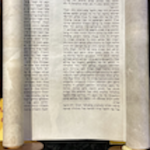Given how store displays go straight from skeletons to Santa, and some churches launch right into “Joy to the World” after a few obligatory verses of “O Come, O Come Emmanuel,” celebrating Advent is downright countercultural. That we make room for Advent as its own season, and not just as a Christmas prelude, is one reason I love being an Episcopalian. But for a number of years, I was also confused about what exactly I was supposed to be doing during Advent, other than lighting purple candles and singing beautiful hymns. I knew that Advent was a time of waiting and preparation. But how, exactly, was I supposed to wait? How, exactly, was I supposed to prepare?
 Many a sermon and Advent devotional suggest that we prepare by cultivating quiet and contemplation. Quiet is an appealing notion during this bustling season. The dark and the cold seem to invite, even demand, quiet and stillness; the long nights are well-suited for reading a book, lingering over a hot meal, or staring into a fire. When I lived in Washington, D.C., St. Columba’s Episcopal Church used to distribute small posters for people to hang in their homes or offices. They read, simply, “Shhh. Quiet. It’s Advent.” I always loved seeing those posters, and appreciated the reminder to disengage from the holiday hubbub now and then.
Many a sermon and Advent devotional suggest that we prepare by cultivating quiet and contemplation. Quiet is an appealing notion during this bustling season. The dark and the cold seem to invite, even demand, quiet and stillness; the long nights are well-suited for reading a book, lingering over a hot meal, or staring into a fire. When I lived in Washington, D.C., St. Columba’s Episcopal Church used to distribute small posters for people to hang in their homes or offices. They read, simply, “Shhh. Quiet. It’s Advent.” I always loved seeing those posters, and appreciated the reminder to disengage from the holiday hubbub now and then.
Our family tries to cultivate small moments of quiet in the busy days leading up to Christmas. We eat by candlelight more often. We take a few minutes each morning to open the next window on the Advent calendar. We sit together on the couch to read a favorite Christmas book. We share family stories as we take ornaments out of their storage boxes to trim the tree.
But the sermons and devotionals and PR campaigns advocating a slower, quieter Advent sometimes overlook the fact that Advent is not only a time of spiritual preparation. Advent is also a time of physical preparation for the holiday that approaches on December 25. Even if we reject over-the-top commercialism and choose more measured ways of celebrating, Christmas is still a holy day and a feast day, worthy of celebration. Even a simple Christmas meal, even modest decorations, even pared-down gift lists and modified family traditions require someone to make some sort of preparations before midnight on December 24. In our house, that someone is usually me, which means that I have a hefty to-do list for the month of December—all the stuff that needs doing on top of the stuff I already do. It’s a busy month.
As I go through the days, baking and wrapping and stringing up lights, I sometimes wonder if I’m doing Advent wrong. The notion of a slowed-down Advent and toned-down Christmas is lovely, but it isn’t always practical. Sometimes the picture I get of the ideal Advent is four straight weeks of prayer and candlelight and floaty instrumental music in the background, and then come December 25th, voila! The family awakens to a few carefully chosen kraft-paper–wrapped gifts under a small tree tastefully adorned with white lights and popcorn garlands, with the scent of a make-ahead breakfast casserole and freshly brewed coffee wafting from the kitchen.
There is nothing magical about how even a simple Christmas celebration happens. It happens because people make lists, cook, bake, buy, wrap, send, clean, decorate, and more. It happens because people use Advent as a time not just of contemplative inner preparation, but also of active outward preparation.
At its heart, Christmas is about the material illuminating the immaterial, about intangible spiritual truths being revealed through tangible physical things. God doesn’t reveal the love and grace at the heart of the universe by beaming deep thoughts into our brains. God reveals love and grace through a newborn baby. There is nothing “spiritual” about a baby; babies are all flesh and need. Similarly, our Christmas traditions communicate what we know about God’s love and grace through stuff that we can see and smell and touch and taste, stuff that speaks to our own flesh and need—light beaming from candles or gaudy twinkling displays, sweet and savory foods, greenery that makes the whole house smell good, well-chosen gifts that assure those we love that we know them well enough to know just what will make them happy.
We define our sacraments (such as baptism and Eucharist) as “outward and visible signs of inward and invisible grace.” Basic material stuff—water, bread, wine—help us understand less tangible but no less real truths about God, us, and the world. Many Christmas traditions are, in a way, sacramental. Material things (light, food, gifts) become tangible reminders of the intangible realities of love and grace.
A central message of Christmas is that God, far from being disinterested in or separate from the material world, is revealed in the material world—in the howling, flailing, hungry body of a newborn baby. At their best, Christmas traditions remind us to look for God everywhere, not only in candlelit quiet but also in flour-covered kitchen counters and a child’s delight in a just-right gift.
Making long to-do lists and checking off tasks one by one, day after day as the calendar marches toward December 25 does not mean that I’m doing Advent wrong. Working and preparing for meaningful Christmas traditions, when we do so mindfully, can remind us precisely what Advent and Christmas are really about.











